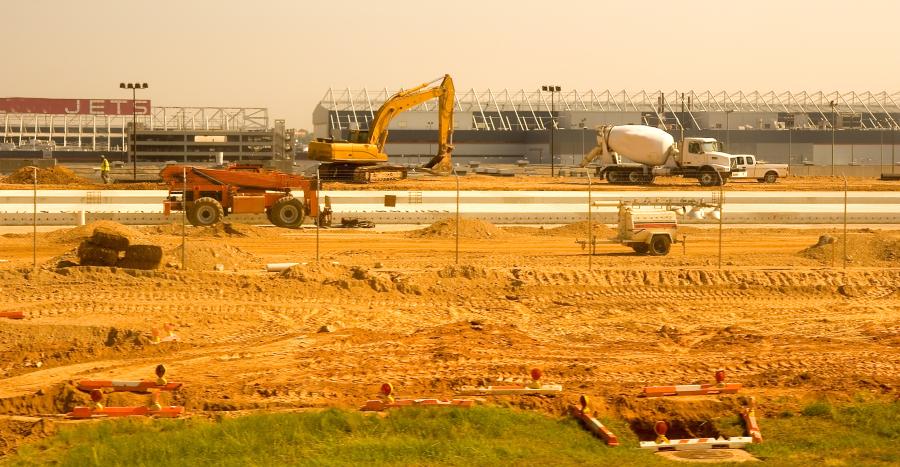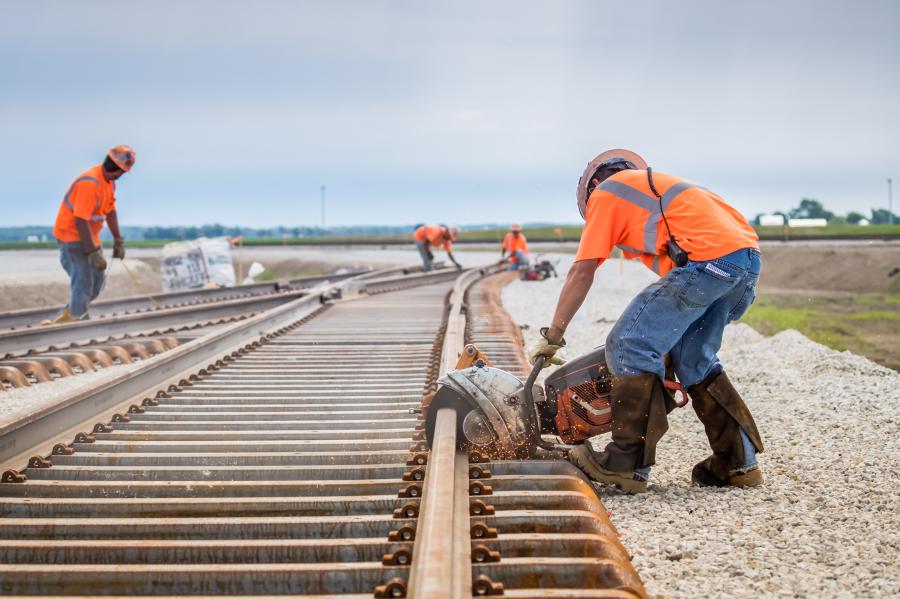The Consolidated Appropriations Act 2022 provides funding for U.S. executive branch departments, including Agriculture, Commerce, Defense, Education, Energy, Health and Human Services, Homeland Security, Housing and Urban Development, Interior, Labor, State, Treasury, Veterans Affairs and Transportation.
Signing the $1.5 trillion 2022 omnibus spending bill into law in mid-March, President Joe Biden released the full benefits of last fall's bipartisan infrastructure and jobs act. Not only does highway work move forward with the spending bill's signing, but energy, maritime, transit, water and airport construction projects launch as well.
Praised by the transportation construction industry for its broad infusion into the U.S. economy for years to come, IIJA couldn't become reality until the omnibus bill was signed.
H.R. 2471, the "Consolidated Appropriations Act, 2022" provides full-year funding through Sept. 30, 2022, for projects and activities of the federal government. Division N of the bill provides supplemental appropriations for fiscal year (FY) 2022 for Ukraine activities.
"Remaining divisions provide authorizations and extensions on a wide variety of government programs and activities," according to a statement from the White House announcing the president's signing.
The Act provides funding for U.S. government operations through September 2022.
This covers all executive branch departments — Agriculture, Commerce, Defense, Education, Energy, Health and Human Services, Homeland Security, Housing and Urban Development, Interior, Labor, State, Transportation, Treasury and Veterans Affairs.
The FY 2022 funding bill passed the House and Senate before arriving at the president's desk. Meanwhile, the House also passed a short-term spending measure as a Plan B in case a continuing resolution, funding the government, expired March 11.
Ending the Stop-Gap
Federal spending programs have operated under a series of stop-gap measures since Oct. 1, 2021.
Passage of the legislation came after delays and three temporary continuing resolutions designed to keep the government afloat until legislators could agree on a final product.
Congress was up against a midnight March 11 deadline before a government shutdown was set to occur.
The short-term measure guaranteed funds remained through mid-March, just in case the Senate did not have enough time to vote on the bill and get it to the president for his signature in the time remaining.
The first installment of the IIJA will not only meet the landmark federal infrastructure law's transportation investments, but will add $4.3 billion to its record levels, according to ARTBA's Newsline.
"It's go time," said Dennis D. Truax, president of the American Society of Civil Engineers (ASCE). "Passage of this bill releases vital funding for states and localities to implement much-needed programs to improve our nation's infrastructure."
The bill prevents the need for another Continuing Resolution this year and allows all funds from the infrastructure bill to be spent rather than being limited to last year's levels, added Truax.
Opening the Piggy Bank
A $1.2 trillion investment in the nation's infrastructure over the next five years, IIJA provides $550 billion in new transportation revenue.
"This comprehensive legislation provides a major boost for improving our surface transportation network, the energy grid, drinking water and wastewater systems, ports and inland waterways, broadband expansion and more," noted ASCE. "The bill also includes the largest-ever investment in the resilience of our built environment, dedicating $50 billion to weatherize and harden these systems, along with creating programs to protect communities from droughts, floods and wildfires."
ARTBA detailed how transportation programs benefit from the omnibus bill's passage:
- Highway investment increases from $48.4 billion in FY 2021 to $66.9 billion and provides an additional $2.5 billion.
- Of that $2.5 billion, $847 million would be reserved for congressionally designated earmarks. The cumulative one-year highway investment increase is $21 billion, or 43 percent.
- The boost to public transportation programs includes an additional $504 million above IIJA amounts.
- The Capital Investment Grant Program, which supports transit construction activities, will grow from $2.1 billion last year to $3.9 billion, or 86 percent.
- The FY 2022 funding provides $554 million in supplemental Airport Improvement Program, noise abatement and earmark funds.
As a result, the measure will provide $8.9 billion for airport capital improvements — a 137 percent increase. The bill would add $775 million to the $3.8 billion directed by the IIJA for multi-modal transportation grants, compared with $1 billion in FY 2021.
According to ASCE, the signed omnibus allows the IIJA's influx of revenue and launches new programs, including:
- The DOT's Promoting Resilient Operations for Transformative, Efficient and Cost-saving Transportation (PROTECT) program. It funds improvements to make infrastructure more resilient to natural disasters.
- DOT's Corridor Identification and Development Program, to facilitate development of intercity passenger rail corridors.
- The EPA's Clean Water Resiliency and Sustainability Program, authorizing $25 million annually for five years and awarding grants to increase the resiliency of publicly owned treatment plants from natural hazards or cybersecurity attacks.
- EPA's Rural and Low-Income Water Assistance Pilot Program awarding grants to develop and implement programs to assist households in need maintain access to drinking water and wastewater.
- A $5 billion FAA discretionary grant program for airport terminal development and connections. For terminal development projects with a special focus on replacing aging infrastructure, it also aims to increase or improve capacity and passenger access, ADA compliance, airport access for historically disadvantaged populations and achieving Leadership in Energy and Environmental Design (LEED) accreditation.
- A DOE program to upgrade the electric grid and ensure reliability and resiliency. Authorized at $5 billion over five years, the program provides grants for projects that demonstrate innovative approaches to transmission, storage and distribution infrastructure.
"IIJA revenue over the next five years has the opportunity to jumpstart the economy, provide jobs and protect Americans from unsafe infrastructure conditions and increasingly severe weather events," said Truax.
Transportation Sector Smiling
AGC and the Transportation Construction Coalition had urged members of both houses to put FY 2022 funding in place. Stephen Sandherr, CEO of the AGC, wanted Congress to "rapidly appropriate the funding it promised to deliver when it passed the Bipartisan Infrastructure bill."
These new investments are a key reason that contractors are so optimistic about the demand for infrastructure, he said. "Yet Congress failed to include these new funds when it passed a temporary spending measure at the end of last year."
The trucking industry is happy that the president signed the omnibus bill because of funding for the Federal Motor Carrier Safety Administration (FMSCA) among other programs.
The bill provides $360 million for FMSCA safety operations and programs and almost $500 million for the agency's safety grants division.
"Specific to trucking, the legislation prohibits funding the enforcement of electronic logging device rules for commercial motor vehicles that transport livestock or insects," reported Transport Topics.
The bill includes $57.4 billion for highway programs; $774.3 million for highway traffic safety grants; $234.3 million for a port infrastructure development program; $182.6 million for pipeline safety operations; and $103.1 million for the DOT Office of Inspector General.
The omnibus bill includes funds for congressionally directed spending projects, or earmarks. The bill's sponsors touted myriad infrastructure and economic provisions tucked in the measure, according to Transport Topics.
"We are encouraged to see the House honor the promise of the bipartisan Infrastructure Investment and Jobs Act by providing the guaranteed public transit funding of the IIJA for Fiscal Year 2022," said Paul Skoutelas, president of the American Public Transportation Association (APTA).
He called it "a transformational investment in public transportation infrastructure that our country so desperately needs."
These investments will enable communities to provide access to opportunities and create family-wage jobs, advance equity, tackle climate change and meet growing and evolving mobility demands, said Skoutelas.
Among the agencies and programs funded by the Consolidated Appropriations Act, 2022 are:
- $775 million earmarked for National Infrastructure Investments where at least $20 million is awarded to assist areas of persistent poverty and historically disadvantaged communities; and an additional $25 million has been included for USDOT's Thriving Communities initiative.
- Federal Railroad Administration funding of $3.3 billion, including $625 million for Consolidated Rail Infrastructure and Safety Improvements grants; at least $150 million for new intercity passenger rail routes; $25 million to counties with the most pedestrian trespasser casualties and $120.9 million for community project funding/congressionally directed spending.
- FRA funding also includes $100 million for intercity passenger rail grants; $2.3 billion for Amtrak, consisting of $874.5 million for the Northeast Corridor and $1.45 billion for the National Network.
- The Federal Transit Administration receives $16.3 billion, including $13.4 billion for transit formula grants; $2.25 billion for Capital Investment Grants Program; $504.3 million for Transit Infrastructure Grants and projects; $175 million for Buses and Bus Facilities grants; and $75 million for Low or No Emission grants.
Also included in the FTA funding is $6.5 million for Ferry Boat grants with at least $3.25 million awarded for low or zero-emission ferries; $12.97 million for ferry service for rural communities; and $200.8 million for community project funding/congressionally directed spending. CEG
Lucy Perry
Lucy Perry has 30 years of experience covering the U.S. construction industry. She has served as Editor of paving and lifting magazines, and has created content for many national and international construction trade publications. A native of Baton Rouge, Louisiana, she has a Journalism degree from Louisiana State University, and is an avid fan of all LSU sports. She resides in Kansas City, Missouri, with her husband, who has turned her into a major fan of the NFL Kansas City Chiefs. When she's not chasing after Lucy, their dachshund, Lucy likes to create mixed-media art.
Read more from Lucy Perry here.
Today's top stories

















